| |||||
| Decades: | |||||
|---|---|---|---|---|---|
| See also: | Other events of 1692 History of China • Timeline • Years | ||||
Events from the year 1692 in China .
Qing Dynasty
| |||||
| Decades: | |||||
|---|---|---|---|---|---|
| See also: | Other events of 1692 History of China • Timeline • Years | ||||
Events from the year 1692 in China .
Qing Dynasty

The Qing dynasty, officially the Great Qing, was a Manchu-led imperial dynasty of China (1636–1912) and the last imperial dynasty in Chinese history. It emerged from the Later Jin dynasty founded by the Jianzhou Jurchens, a Tungusic-speaking ethnic group who unified other Jurchen tribes to form a new "Manchu" ethnic identity. The dynasty was officially proclaimed in 1636 in Manchuria. It seized control of Beijing in 1644, then later expanded its rule over the whole of China proper and Taiwan, and finally expanded into Inner Asia. The dynasty lasted until 1912 when it was overthrown in the Xinhai Revolution. In Chinese historiography, the Qing dynasty was preceded by the Ming dynasty and succeeded by the Republic of China. The multiethnic Qing dynasty lasted for almost three centuries and assembled the territorial base for modern China. It was the largest imperial dynasty in the history of China and in 1790 the fourth-largest empire in world history in terms of territorial size. With 419,264,000 citizens in 1907, it was the most populous country in the world at the time.
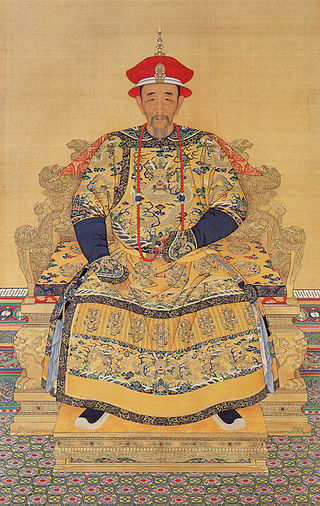
The Kangxi Emperor, also known by his temple name Emperor Shengzu of Qing, born Aisin-Gioro Xuanye, was the third emperor of the Qing dynasty, and the second Qing emperor to rule over China proper, reigning from 1661 to 1722.

The Yongzheng Emperor, also known by his temple name Emperor Shizong of Qing, born Aisin-Gioro Yinzhen, was the fourth emperor of the Qing dynasty, and the third Qing emperor to rule over China proper. He reigned from 1722 to 1735. A hard-working ruler, the Yongzheng Emperor's main goal was to create an effective government at minimal expense. Like his father, the Kangxi Emperor, the Yongzheng Emperor used military force to preserve the dynasty's position.

Wu Sangui, courtesy name Changbai (長白) or Changbo (長伯), was a notorious Ming dynasty military officer who played a key role in the fall of the Ming dynasty and the founding of the Qing dynasty in China. In Chinese folklore, Wu Sangui is regarded as a disreputable Han Chinese traitor who played a pivotal role in several historical events, including the Battle of Shanhai Pass, Manchu invasion of China, the suppression of Southern Ming resistances and the execution of the Yongli Emperor, and eventually double-crossed both of his masters, the Ming and the Qing dynasties.

Jinshi was the highest and final degree in the imperial examination in Imperial China. The examination was usually taken in the imperial capital in the palace, and was also called the Metropolitan Exam. Recipients are sometimes referred to in English-language sources as Imperial Scholars.

The Revolt of the Three Feudatories, also known as the Rebellion of Wu Sangui, was a rebellion in China lasting from 1673 to 1681, during the early reign of the Kangxi Emperor of the Qing dynasty (1644–1912). The revolt was led by the three lords of the fiefdoms in Yunnan, Guangdong and Fujian provinces against the Qing central government. These hereditary titles had been given to prominent Han Chinese defectors who had helped the Manchu conquer China during the transition from Ming to Qing. The feudatories were supported by Zheng Jing's Kingdom of Tungning in Taiwan, which sent forces to invade Mainland China. Additionally, minor Han military figures, such as Wang Fuchen and the Chahar Mongols, also revolted against Qing rule. After the last remaining Han resistance had been put down, the former princely titles were abolished.
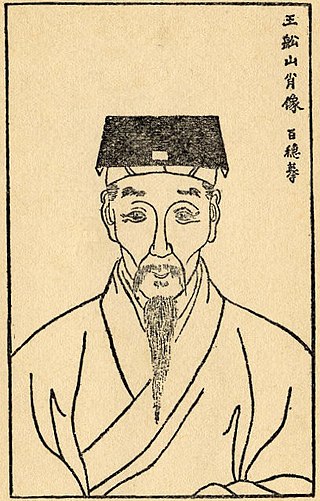
Wang Fuzhi (Chinese: 王夫之; pinyin: Wáng Fūzhī; Wade–Giles: Wang2 Fu1-chih1; 1619–1692), courtesy name Ernong (而農), pseudonym Chuanshan (船山), was a Chinese essayist, historian, and philosopher of the late Ming, early Qing dynasties.
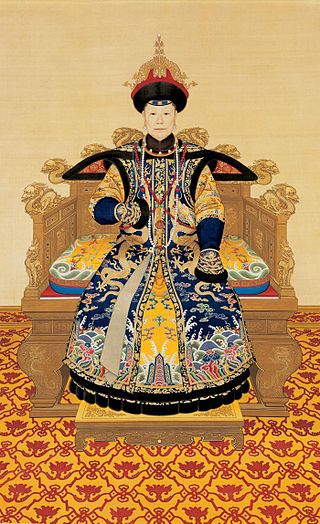
Empress Xiaoshengxian, of the Manchu Bordered Yellow Banner Niohuru clan, was a posthumous name bestowed to the consort of Yinzhen, the Yongzheng Emperor and mother of Hongli, the Qianlong Emperor. She was honoured as Empress Dowager Chongqing during the reign of her son and posthumously honoured as empress, although she never held the rank of empress consort during her lifetime.

Empress Xiaoyiren, of the Manchu Bordered Yellow Banner Tunggiya clan, was a posthumous name bestowed to the wife and third empress consort of Xuanye, the Kangxi Emperor. She was empress consort of Qing in 1689.
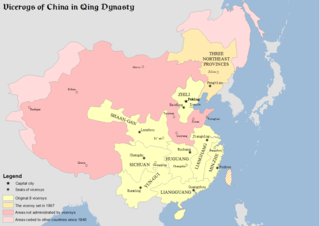
The Viceroy of Liangguang or Viceroy of the Two Guangs, was one of eight regional Viceroys during the Ming and Qing dynasties. The two Guang referred to Guangdong and Guangxi provinces. The areas under the Viceroy's jurisdiction included present-day Guangdong and Guangxi provinces, as well as Hainan Province.
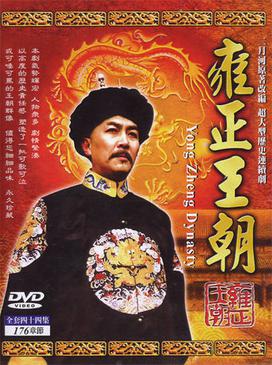
Yongzheng Dynasty is a 1999 Chinese historical television series starring Tang Guoqiang and Jiao Huang. The series, spanning 44 episodes, occupied the CCTV-1 prime time slot; after its premiere, there have been many re-runs of the show on television networks in mainland China, Taiwan and Hong Kong. The series was adapted from Eryue He's historical novels, which are loosely based on historical events in the reigns of the Kangxi and Yongzheng Emperors in the Qing dynasty (1644–1911). The series was followed by a 2001 prequel, Kangxi Dynasty, and a 2002 sequel, Qianlong Dynasty, both of which were also based on Eryue He's novels.
The history of the Qing dynasty began in 1636, when Manchu chieftain Hong Taiji founded the dynasty, and lasted until 1912, when Puyi abdicated the throne in response to the Xinhai Revolution. The final imperial dynasty of China, the Qing dynasty reached heights of power unlike any of the Chinese dynasties which preceded it, engaging in large-scale territorial expansion which ended with embarrassing defeat and humiliation to the foreign powers whom they believe to be inferior to them. The Qing dynasty's inability to successfully counter Western and Japanese imperialism ultimately led to its downfall, and the instability which emerged in China during the final years of the dynasty ultimately paved the way for the Warlord Era.
Events from the year 1662 in China.
Events from the year 1661 in the Qing dynasty.
Events from the year 1663 in China. Also known as 壬寅 4359 or 4299 to 卯年 4360 or 4300 in the Earthly Branches calendar.
Events from the year 1665 in China.
Events from the year 1667 in China.
Events from the year 1686 in China.
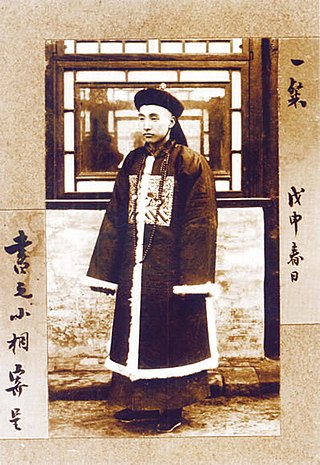
The early Qing emperors adopted the bureaucratic structures and institutions from the preceding Ming dynasty but split rule between the Han and Manchus with some positions also given to Mongols. Like previous dynasties, the Qing recruited officials via the imperial examination system until the system was abolished in 1905. The Qing divided the positions into civil and military positions, each having nine grades or ranks, each subdivided into a and b categories. Civil appointments ranged from an attendant to the emperor or a Grand Secretary in the Forbidden City (highest) to being a prefectural tax collector, deputy jail warden, deputy police commissioner, or tax examiner. Military appointments ranged from being a field marshal or chamberlain of the imperial bodyguard to a third class sergeant, corporal or a first or second class private.
Chen Menglei was a Qing dynasty scholar-writer known for being the chief editor, compiler, and author of the Gujin Tushu Jicheng Chinese encyclopedia. In 1670, he became a Jinshi. Chen Menglei conducted research for over 50 years, covering more than 10,000 volumes of books, and in 1701 was entrusted by the Kangxi Emperor to compile the Gujin Tushu Jicheng encyclopedia, which Chen completed in four and a half years.